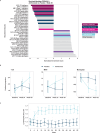Type I interferon blockade with anifrolumab in patients with systemic lupus erythematosus modulates key immunopathological pathways in a gene expression and proteomic analysis of two phase 3 trials
- PMID: 38569851
- PMCID: PMC12056589
- DOI: 10.1136/ard-2023-225445
Type I interferon blockade with anifrolumab in patients with systemic lupus erythematosus modulates key immunopathological pathways in a gene expression and proteomic analysis of two phase 3 trials
Abstract
Introduction: Anifrolumab is a type I interferon (IFN) receptor 1 (IFNAR1) blocking antibody approved for treating patients with systemic lupus erythematosus (SLE). Here, we investigated the immunomodulatory mechanisms of anifrolumab using longitudinal transcriptomic and proteomic analyses of the 52-week, randomised, phase 3 TULIP-1 and TULIP-2 trials.
Methods: Patients with moderate to severe SLE were enrolled in TULIP-1 and TULIP-2 and received intravenous anifrolumab or placebo alongside standard therapy. Whole-blood expression of 18 017 genes using genome-wide RNA sequencing (RNA-seq) (pooled TULIP; anifrolumab, n=244; placebo, n=258) and 184 plasma proteins using Olink and Simoa panels (TULIP-1; anifrolumab, n=124; placebo, n=132) were analysed. We compared treatment groups via gene set enrichment analysis using MetaBase pathway analysis, blood transcriptome modules, in silico deconvolution of RNA-seq and longitudinal linear mixed effect models for gene counts and protein levels.
Results: Compared with placebo, anifrolumab modulated >2000 genes by week 24, with overlapping results at week 52, and 41 proteins by week 52. IFNAR1 blockade with anifrolumab downregulated multiple type I and II IFN-induced gene modules/pathways and type III IFN-λ protein levels, and impacted apoptosis-associated and neutrophil extracellular traps-(NET)osis-associated transcriptional pathways, innate cell activating chemokines and receptors, proinflammatory cytokines and B-cell activating cytokines. In silico deconvolution of RNA-seq data indicated an increase from baseline of mucosal-associated invariant and γδT cells and a decrease of monocytes following anifrolumab treatment.
Discussion: Type I IFN blockade with anifrolumab modulated multiple inflammatory pathways downstream of type I IFN signalling, including apoptotic, innate and adaptive mechanisms that play key roles in SLE immunopathogenesis.
Keywords: Autoimmune Diseases; Biological Therapy; Lupus Erythematosus, Systemic.
© Author(s) (or their employer(s)) 2024. Re-use permitted under CC BY-NC. No commercial re-use. See rights and permissions. Published by BMJ on behalf of EULAR.
Conflict of interest statement
Competing interests: TB is an employee and stock holder of AstraZeneca; HS is an employee and stock holder of AstraZeneca; PJN was an employee of AstraZeneca at the time the study was being conducted and is an employee and stock holder of GSK; PGG is an employee and stock holder of AstraZeneca; MNL was an employee of AstraZeneca at the time the study was being conducted; MR was an employee and stock holder of AstraZeneca at the time the study was being conducted and is an employee and stock holder of GSK; WIW is an employee and stock holder of AstraZeneca; is applying for two patents (No. 17/999257; No. 18/556733); NF is an employee and stock holder of AstraZeneca; DM is an employee and stock holder of AstraZeneca; RT is an employee and stock holder of AstraZeneca; EFM received grants/contracts from AbbVie, Amgen, AstraZeneca, Biogen, BMS, Eli Lilly, EMD Serono, Genentech, GSK, Janssen, Novartis, Takeda and UCB; received consulting feed from AbbVie, AstraZeneca, Capella, Eli Lilly, EMD Serono, Galapagos, IGM, Novartis, Servier, Wolf, and Zenas; received payment/honoraria from AstraZeneca, BMS, GSK, and Roche; received support for meetings/travel from AstraZeneca and Roche; participated on Data Safety Monitoring/Advisory Boards of AstraZeneca, EMD Serono, Galapagos, Janssen, Novartis, and Takeda; is the Board Director of Rare Voices Australia and Exosome Biosciences Pty; RAF received grants/contracts, consulting fees, payment/honoraria, and support for attending meetings/travel from AstraZeneca and participated on a Data Safety Monitoring/Advisory Board of AstraZeneca; EMV received grants/contracts from AstraZeneca and Sandoz; consulting fees from AbbVie, AstraZeneca, CESAS, Elli Lilly, Novartis, Otsuka, Pfizer, Roche, UCB; payment/honoraria from AstraZeneca, Novastis and Otsuka; support for attending meetings/travel from Otsuka; participated on Data Safety Monitoring/Advisory Boards of Aurinia; is the General Secretary in SLEuro; CC is an employee and stock holder of AstraZeneca; AP is an employee and stockholder of AstraZeneca; HA-M was an employee and stock holder of AstraZeneca at the time the study was being conducted; PZB is an employee and stock holder of AstraZeneca; EC is an employee and stock holder of AstraZeneca.
Figures




References
Publication types
MeSH terms
Substances
LinkOut - more resources
Full Text Sources

